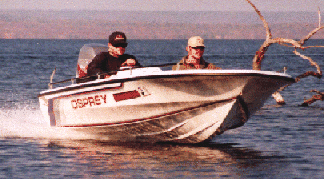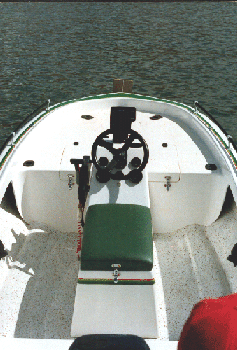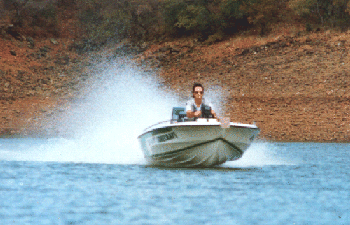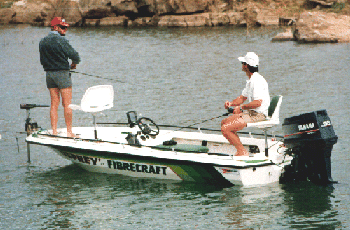FIBRECRAFT/CHASE MARINE
OSPREY
Specifications | Boat
report | Results
Specifications
Length
15' 0"
4.57m
Width
6' 0"
2.16m
Weight - Boat
250 kg
Recommended Horsepower
40 - 115hp
Standard Equipment
-
Hull and top deck, front casting deck with two dry hatches and swivel
seat
-
Rear Bench seat with hinged lockable lid
-
Centre console with padded seat and two drink holders OR side mounted
console with two swivel seats.
-
Side mounted rod racks
-
Anodized aluminium boat trim
-
Battery box, fuel tank and oil tank trays
-
Rust less hardware, hinges and fasteners
-
Transom bracket/jack plate, bilge pump and six colour gel coat
Optional Extras
-
Handrails, rear swivel seat, fire extinguisher, Rideguide steering,
bilge pump, flush rod holders, drink holders, livewell, ski pole.
back to top
Boat
Report
(by kind permission of the African
Fisherman August 1993)
The Osprey continues a line of tradition for which Fibrecraft (Pvt)
Ltd. are well known, that of building quality boats and naming them after
majestic birds. Although under a new name, the Osprey has evolved from
the Ranger series manufactured by Fibrecraft, and to fully appreciate this
fine hull it is necessary to trace its ancestry.
Based originally on a Glastron hull (which has its origins in America),
the Ranger first made its appearance 12 years ago. The hull has been developed
over the years with two different top deck configurations and has been
marketed as a River Ranger and a Bass Ranger. The Rangers success and popularity
is celebrated by more than 250 boats sold over the years, with many top
fishermen owning a Ranger at one time or another.
One such angler, Rod Ferreira, is well known for his Bass Ranger,
which, with a little extra strengthening and performance modifications,
was powered by no less than 225 Horsepower !! No small mill for 14' 6"
boat.
Although this exceeded the recommended horsepower rating of the
Ranger, (and is not recommended by the manufacturer) the boat performed
admirably and often exceeded 74 mph with a very competent Rod at the wheel.
The new Osprey's hull and running surfaces have been fine tuned
still further, and new moulds made. This coupled with the wider, longer
(now 15 foot) configuration was our test boat.
Construction
Construction is of a combination of fibreglass mats, woven roving
and a new high strength material known as Core Mat. The transom is constructed
using two sheets of 19mm Marine Ply laminated with Fibreglass and kneed
into the floor. Marine Ply longitudinal stringers are sealed by the floor
creating five separate flotation chambers under the floor. Fittings are
either high impact polypropylene, nylon, aluminium or imported stainless
steel. All fittings are mounted using either stainless steel or brass screws.
The use of such weather resistant accessories enhances the overall finish
of the boat.
 Ivor
Kesson, managing director of Fibrecraft, is not afraid to try new ideas,
and although the concept of a centre console is not new, this particular
configuration was unfamiliar to me. The console and driving seat are an
integral unit, aligned longitudinally in the centre of he hull. At first
glance the unit resembles a jet ski that has been incorporated into the
deck. Whilst I was a little unsure at first, once accustomed to the straddle
position, I found it most comfortable. One has the impression of riding
the boat rather than driving it. In tight turns and manoeuvres the extra
support gained by clenching the seating box between ones knees is impressive.
In really rough water conditions, rising up above the seat into a jockey
type posture enables the pilot to ride the rough water comfortably. This
position also facilitates good forward vision when navigating.
Ivor
Kesson, managing director of Fibrecraft, is not afraid to try new ideas,
and although the concept of a centre console is not new, this particular
configuration was unfamiliar to me. The console and driving seat are an
integral unit, aligned longitudinally in the centre of he hull. At first
glance the unit resembles a jet ski that has been incorporated into the
deck. Whilst I was a little unsure at first, once accustomed to the straddle
position, I found it most comfortable. One has the impression of riding
the boat rather than driving it. In tight turns and manoeuvres the extra
support gained by clenching the seating box between ones knees is impressive.
In really rough water conditions, rising up above the seat into a jockey
type posture enables the pilot to ride the rough water comfortably. This
position also facilitates good forward vision when navigating.
The Osprey we tested was fitted with a 90 hp Yamaha, which is the
ideal recommended horsepower for this craft, although it will perform quite
comfortably with a 40 hp. In my opinion the 90hp provided ample power.
We played with several different performance propellers and attained
a maximum top speed of about 53 mph,
 although
the standard Yamaha prop gave us the best all round performance. Putting
the boat through its paces, I whipped into some tight turns at varying
speeds and trim settings, progressively tightening the turn whilst adding
power - she stuck to the water and was very responsive, never feeling as
if she would break and slide. Opening her up on the straights and trimming
for maximum speed, I was able to to set her up with just the motor and
a small part of the hull was in the water - The ride was exhilarating.
The hull held steady on the water and at no time at all did I
although
the standard Yamaha prop gave us the best all round performance. Putting
the boat through its paces, I whipped into some tight turns at varying
speeds and trim settings, progressively tightening the turn whilst adding
power - she stuck to the water and was very responsive, never feeling as
if she would break and slide. Opening her up on the straights and trimming
for maximum speed, I was able to to set her up with just the motor and
a small part of the hull was in the water - The ride was exhilarating.
The hull held steady on the water and at no time at all did I
feel that I was going to lose control. Ivor Kesson who has an impressive
boat racing background, seemed able to squeeze that last bit of performance
out of the boat, making it look striking on the water.
Fishability
As a fishing boat the Osprey is versatile. At one stage we fished
four people from the boat and di not really get in each others way. The ability to walk around the console enables complete
control when fighting a fish. Many times during the weekend, I found myself
standing on the console seat whilst fishing, especially when there were
four of us on the boat. The front deck fishes two comfortably and possibly
even three if the pedestal seat is removed. With two fishing from the front
deck the boat maintains a level attitude with good freeboard, which is
important in rough water.
each others way. The ability to walk around the console enables complete
control when fighting a fish. Many times during the weekend, I found myself
standing on the console seat whilst fishing, especially when there were
four of us on the boat. The front deck fishes two comfortably and possibly
even three if the pedestal seat is removed. With two fishing from the front
deck the boat maintains a level attitude with good freeboard, which is
important in rough water.
Although our boat was fitted with a back pedestal seat, I found
it was in the way more than it was useful. As a general fishing boat or
river boat this extra seat is superfluous and in future models, will be
an optional extra rather than a standard fitting. Alternatively a ski pole
may be fitted into the mount for those that do not use the boat purely
for fishing. If required, the short back deck could be padded and double
as a seat for passengers without detracting from its function as a casting
deck.
As this configuration is the fore runner to the "Super Bass Ranger"
currently being developed, it incorporates many of the features of a Bas
boat. Under deck storage fore and aft that has been designed to carry at
least four Plano Tackle boxes (fore) and two caddy tanks, batteries etc.
as well as additional tackle boxes (aft). A live well may be added beneath
the front deck if required. Under the centre console additional space is
available for storing cooler boxes and the like. All hatches are water
tight and incorporate the new self draining channels in the lids, this
is a definite plus when one considers our climate.
With three people on the boat it is possible to stow all items one
normally trips over, leaving the decks free for fighting fish. Ivor has
also taken cognisance of the need for small cubby-hole type storage compartments
for tucking away sunglasses, sun creams and the smaller items that normally
levitate when the boat is in motion.
As it is intended that the Osprey supercede the River Ranger, the
boat has obviously been designed with the river and small dams in mind.
The high centre console gives good all round vision, an important factor
on the river.
 The Osprey
reflects the new commitment to quality we talked of in the last issue.
Apart from the imported fittings and high standard of finish, Ivor has
built some excellent lines into the deck giving a pleasing and attractive
modern shape to the boat. The gel coat stripes are of a very high standard
and certainly enhanced the overall impression. Final finish may be tailored
to suit the owners pocket. Extras such as carpeting, custom electric's,
mounting of accessories etc., are available on request. The boat is also
available with a side console for the unconverted.
The Osprey
reflects the new commitment to quality we talked of in the last issue.
Apart from the imported fittings and high standard of finish, Ivor has
built some excellent lines into the deck giving a pleasing and attractive
modern shape to the boat. The gel coat stripes are of a very high standard
and certainly enhanced the overall impression. Final finish may be tailored
to suit the owners pocket. Extras such as carpeting, custom electric's,
mounting of accessories etc., are available on request. The boat is also
available with a side console for the unconverted.
I have no major criticisms of the Osprey. As I've already mentioned,
the aft pedestal seat is unnecessary but this will not appear on the standard
version. I would like to see the plain fibreglass edges covered or finished
with either aluminium edging or something similar (fibreglass edges were
neatly rounded after moulding) as this adds to the overall presentation
of the craft. Again this is minor and probably available on request.
back to top
Test
Results
Performance
Load
- Two people, 30 litres petrol
Propeller
- Aluminium 19 inch pitch
Engine
- 90 hp Yamaha
Minimum
Planing Time
- 3 Seconds
Minimum
Planing speed - 26 km/h
|
1
Poor
|
2
Poor
|
3
Ave
|
4
Ave
|
5
Ave
|
6
Good
|
7
Good
|
8
Good
|
9
Excel
|
10
Excel
|
| Trailer Construction |
. |
. |
. |
. |
. |
. |
. |
 |
. |
. |
| Launching |
. |
. |
. |
. |
. |
. |
. |
. |
 |
. |
| Retrieving |
. |
. |
. |
. |
. |
. |
. |
. |
 |
. |
| Hull moulding |
. |
. |
. |
. |
. |
. |
. |
. |
 |
. |
| Deck moulding |
. |
. |
. |
. |
. |
. |
. |
. |
 |
. |
| Hatches and Stowage |
. |
. |
. |
. |
. |
. |
. |
 |
. |
. |
| Gel coat |
. |
. |
. |
. |
. |
. |
. |
. |
 |
. |
| Upholstery |
. |
. |
. |
. |
. |
 |
. |
. |
. |
. |
| Steering , Accessory and wiring installation |
. |
. |
. |
. |
. |
. |
 |
. |
. |
. |
| Motor Installation |
. |
. |
. |
. |
. |
. |
. |
 |
. |
. |
| Overall presentation |
. |
. |
. |
. |
. |
. |
. |
. |
 |
. |
| Fittings installation |
. |
. |
. |
. |
. |
. |
. |
 |
. |
. |
| Fishability - Kariba |
. |
. |
. |
. |
. |
 |
. |
. |
. |
. |
|
- Inland Dam |
. |
. |
. |
. |
. |
. |
. |
. |
. |
 |
| Stowage |
. |
. |
. |
. |
. |
. |
. |
. |
 |
. |
| Stability - Maximum speed |
. |
. |
. |
. |
. |
. |
. |
. |
 |
. |
|
- at rest |
. |
. |
. |
. |
. |
. |
. |
. |
 |
. |
back to top
Back to Index
 Ivor
Kesson, managing director of Fibrecraft, is not afraid to try new ideas,
and although the concept of a centre console is not new, this particular
configuration was unfamiliar to me. The console and driving seat are an
integral unit, aligned longitudinally in the centre of he hull. At first
glance the unit resembles a jet ski that has been incorporated into the
deck. Whilst I was a little unsure at first, once accustomed to the straddle
position, I found it most comfortable. One has the impression of riding
the boat rather than driving it. In tight turns and manoeuvres the extra
support gained by clenching the seating box between ones knees is impressive.
In really rough water conditions, rising up above the seat into a jockey
type posture enables the pilot to ride the rough water comfortably. This
position also facilitates good forward vision when navigating.
Ivor
Kesson, managing director of Fibrecraft, is not afraid to try new ideas,
and although the concept of a centre console is not new, this particular
configuration was unfamiliar to me. The console and driving seat are an
integral unit, aligned longitudinally in the centre of he hull. At first
glance the unit resembles a jet ski that has been incorporated into the
deck. Whilst I was a little unsure at first, once accustomed to the straddle
position, I found it most comfortable. One has the impression of riding
the boat rather than driving it. In tight turns and manoeuvres the extra
support gained by clenching the seating box between ones knees is impressive.
In really rough water conditions, rising up above the seat into a jockey
type posture enables the pilot to ride the rough water comfortably. This
position also facilitates good forward vision when navigating.
 although
the standard Yamaha prop gave us the best all round performance. Putting
the boat through its paces, I whipped into some tight turns at varying
speeds and trim settings, progressively tightening the turn whilst adding
power - she stuck to the water and was very responsive, never feeling as
if she would break and slide. Opening her up on the straights and trimming
for maximum speed, I was able to to set her up with just the motor and
a small part of the hull was in the water - The ride was exhilarating.
The hull held steady on the water and at no time at all did I
although
the standard Yamaha prop gave us the best all round performance. Putting
the boat through its paces, I whipped into some tight turns at varying
speeds and trim settings, progressively tightening the turn whilst adding
power - she stuck to the water and was very responsive, never feeling as
if she would break and slide. Opening her up on the straights and trimming
for maximum speed, I was able to to set her up with just the motor and
a small part of the hull was in the water - The ride was exhilarating.
The hull held steady on the water and at no time at all did I
 each others way. The ability to walk around the console enables complete
control when fighting a fish. Many times during the weekend, I found myself
standing on the console seat whilst fishing, especially when there were
four of us on the boat. The front deck fishes two comfortably and possibly
even three if the pedestal seat is removed. With two fishing from the front
deck the boat maintains a level attitude with good freeboard, which is
important in rough water.
each others way. The ability to walk around the console enables complete
control when fighting a fish. Many times during the weekend, I found myself
standing on the console seat whilst fishing, especially when there were
four of us on the boat. The front deck fishes two comfortably and possibly
even three if the pedestal seat is removed. With two fishing from the front
deck the boat maintains a level attitude with good freeboard, which is
important in rough water.

 The Osprey
reflects the new commitment to quality we talked of in the last issue.
Apart from the imported fittings and high standard of finish, Ivor has
built some excellent lines into the deck giving a pleasing and attractive
modern shape to the boat. The gel coat stripes are of a very high standard
and certainly enhanced the overall impression. Final finish may be tailored
to suit the owners pocket. Extras such as carpeting, custom electric's,
mounting of accessories etc., are available on request. The boat is also
available with a side console for the unconverted.
The Osprey
reflects the new commitment to quality we talked of in the last issue.
Apart from the imported fittings and high standard of finish, Ivor has
built some excellent lines into the deck giving a pleasing and attractive
modern shape to the boat. The gel coat stripes are of a very high standard
and certainly enhanced the overall impression. Final finish may be tailored
to suit the owners pocket. Extras such as carpeting, custom electric's,
mounting of accessories etc., are available on request. The boat is also
available with a side console for the unconverted.